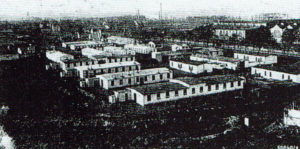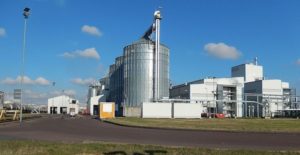Reading time: 6 minutes

THINGS TO KNOW A garrison town became a nationally influential industrial location – Wittenberg’s transformation into an industrial town began late, but was then unstoppable. Its development during the industrialisation period was particularly evident in Wittenberg’s district Piesteritz escepially with the ‘SKW Stickstoffwerke Piesteritz GmbH’.
It was not until Mai 30th 1873 with the order to de-fortify the town of Wittenberg that industrialisation began in this area. Now Wittenberg could expand to the west and east, the building restrictions in the surrounding area were largely lifted. Favourable traffic conditions, existing labour force and the possibility of generating electricity from lignite in the Bitterfeld mining district offered good location conditions for companies. In particular, the expansion of the Elbe port as a transhipment port from water to rail in 1883 as well as Wittenberg’s location on the main Berlin-Munich artery and the freight bypass for Berlin had a positive effect on the city of Wittenberg.
At the end of the 19th century, large industrial companies such as the ‘Eisenwerk Joly Wittenberg KG’, the ‘Gummiwerke ELBE AG’, the ‘Kant Chokoladenfabrik AG’ (today’s ‘Wikana Süß- und Dauerbackwaren GmbH’) and the ‘Westfälisch-Anhaltischen Sprengstoff AG’ (WASAG) settled here. But Wittenberg did not become an important chemical site until the Reichsschatzamt commissioned the ‘Bayerische Stickstoffwerke AG’ to build a new factory.
Why of all things were the Stickstoffwerke so important for Wittenberg’s industrialization? How did the factory affect Piesteritz in particular? And what basic principles were necessary to ensure that it could even come to this?
Origin of the industrial giant
The decision for the location of the new nitrogen producer was made at Piesteritz. The contract for the foundation of the ‘Reichsstickstoffwerke Piesteritz’ was signed two weeks before the start of construction on March 15th 1915, and within 9 months a factory costing 8.6 million Goldmarks was built, according to plans by Karl Janisch. For this purpose, farmers sold a total of 240 acres (60 hectares) of land, coniferous forest was laid down and levelled before Wittenberg prisoners of war began the actual construction.
„The last remaining woodland disappeared, and the area lost its rural character for good. The community of Piesteritz became a decidedly industrial place.”

The energy supply came from the lignite-fired power station in Golpa, 25 km away. In addition, a large power station was built in record time in Zschornewitz, which was completed in 1915.
This enabled the nitrogen plants to go into full operation by the end of the year and produce calcium cyanamide for the first time on January 14th 1916. This was also urgently needed, as the demand for raw materials had risen sharply during the First World War, especially as Chilean saltpetre had been lost as a fertiliser due to the British sea blockade. Although the process for producing calcium cyanamide from the nitrogen in the air had already been developed, production in the huge quantities required for the war (150,000 tonnes per year were to be produced) was new.
Calcium cyanamide replaced saltpetre and could be used as gunpowder and later as fertiliser, and it was also important for the production of ammonia. It was produced using the Frank-Caro process. After several extensions, the factory was finally able to produce calcium carbide, ammonia, nitric acid, ammonium nitrate and sodium nitrate in addition to calcium cyanamide in 1918.
TECHNICAL FACTS. In 1915 the Reichsstickstoffwerke contained the following large-scale plants:
After the end of the war, the factory was inevitably privatised in 1920 and renamed ‘Mitteldeutsche Stickstoffwerke AG Piesteritz’, but the administration itself initially remained in the hands of the Reichsschatzamt. In 1923, together with ‘Bayerische Kraftwerke AG’, ‘Bayerische Stickstoffwerke AG’ and the Chorzow factory, it was incorporated into ‘Vereinigte Industrie Unternehmungen AG’ (VIAG), a company newly founded by the German Reich. In 1926, it was to be leased to ‘Bayerische Stickstoffwerke AG’ and in 1933 became part of this company.
During the early years, the SKW were continually expanded and, for example, four large phosphorus furnaces (1927) or a large-scale plant for the production of highly concentrated nitric acid (1936) were added, thus compensating for the ammonia production which had become inefficient due to the development of the Haber-Bosch process. The factory has been able to distinguish itself to this day not only by its ‘range of specialities’ and its many possibilities, but also by its role in the social fabric of the city of Wittenberg.
Housing for the workers
For with the construction of the Reich nitrogen works, thousands of job seekers from structurally weak regions such as Bavaria, Silesia or Westphalia came to Piesteritz.
„In this small shantytown there was always a large influx of people from all parts of Germany … but many moved from there again, except for a few.”
The work in the factory was monotonous and dirty and good living conditions were not available in Piesteritz at that time. In order to retain the necessary core workforce in spite of this, the Stickstoffwerke introduced a fairly extensive social programme for the workers, which included a canteen service and a works doctor. The pay was comparatively high, and the flexible working hours made possible by the so-called ‘Krümpersystem’ were also pleasant and could be adapted to the production rhythm of the factory. The previous vocational training was also unusual, but proved the difficulty to find qualified workers.

To help workers settle down, the factory also promoted housing construction. In fact, the number of inhabitants of Piesteritz had more than doubled within 10 years from 2,358 to 5,800 people. The existing flats were not sufficient, even though all habitable rooms in the village were used in a ‘shift rhythm’ and some Piesteritz families took in 6 to 8 so-called ‘boarders’ for a small rent. The residential barracks quickly erected by the Stickstoffwerke accommodated whole families, but also under difficult living conditions.
„The establishment of the Reichsstickstoffwerke brought such an influx of people that the housing shortage became immeasurable.“

The construction of the settlement ‘Sachsenland’ for WASAG employees and the ‘Piesteritzer Werkssiedlung’ (Piesteritz factory settlement), which is now a listed building, were to provide some relief. In 1919, after a construction period of three years, the settlement offered about 400 residential houses for 2000 SKW employees on an area of 12 hectares and was supplied with drinking water by its own waterworks.
The small garden city, designed by Paul Schmitthenner and Otto Rudolf Salvisberg, was extraordinary, as it accommodated workers and superiors alike, who could grow fruit and vegetables in their gardens independently. With its department store, pharmacy, school, common rooms and finally a church for the predominantly catholic workers, the settlement had a modern infrastructure, which was also necessary, after all, the nearest shopping facilities were located in the centre of Wittenberg, about 6 km from the factory.
New social life in the former farming village
The concept worked: Many workers settled in Piesteritz. In 1924, they made up 41% of the population of Piesteritz, almost half of the total. This also changed the social life of the once so quiet farming village considerably. Unrest set in with the workers’ families, and police protection was considerably increased due to the increasing frequency of street conflicts.
„The coffees shot up like mushrooms. A lot of money was earned and easily spent again.“
This development did not go unnoticed by the town of Wittenberg, to which Piesteritz was not to belong until 1950. The old provincial town dwellers now felt the influx of the working masses from all sides. Even with the expansion of WASAG in Reinsdorf, workers had come, demanding more and more money for the expansion of the social infrastructure, which did not please the Protestant citizens of the city, who were more concerned with the representation of Wittenberg as a cultural city.
In order to prevent a decline in morals, separate entertainment evenings were even organized for female workers, but these were not well received due to the long distances to Wittenberg’s inner city. Piesteritz became more and more independent of Wittenberg through the development of the infrastructure. Although the cosy life in “patriarchal simplicity” in Piesteritz had dissolved, a progressive industrial community was created, which by 1927 already had a cinema, three doctors, a weekly market, a bathing establishment, a gymnasium and a sports field as well as numerous sports and political clubs.
A development which, in addition to the “Red Piesteritz” – the social democratic workers had a decisive influence on the political attitude of the town – was evident throughout Wittenberg and continued for a long time, because the chemical industry was to remain the town’s main employer until the collapse of the GDR.
Science as the basis for Piesteritz’ change
In the end, it was only luck that Wittenberg was chosen for the construction of the ‘Reichsstickstoffwerke’ because of its good site conditions. Of course, other large chemical companies such as WASAG also played a role, but Wittenberg’s greatest importance as an industrial location today is due to the SKW, which is the largest ammonia and urea producer in Germany.
It also likes to call itself a “lighthouse” within the whole of Germany, after all it is one of the most innovative mineral fertilizer companies in Europe. Over 5000 tons of products are manufactured on a plant area of 220 hectares and 850 employees are employed. In addition to the SKW, thirty other primarily industrial companies have settled in the Agro-Chemie Park (which was founded in 2005), making Piesteritz the most important industrial sector in the city of Wittenberg – and SKW the symbol of industrialisation in Wittenberg.
That it could come to this point is closely connected to the social, technical and scientific situation at the beginning of the 20th century. Far-sighted chemists had recognized early on how important saltpetre imported from Chile was for the production of fertilizers and explosives.
„If a war were to break out today between two great powers, one of which would be able to prevent the export of saltpetre from the few ports of Chile, it would make its opponent virtually unfit for battle.”
Ostwald should be right. After all, it was the shortage of Chilean saltpetre caused by the First World War that made an alternative to saltpetre necessary. This was to be the production of calcium cyanamide from the air, first practiced in Norway in 1905.
The basis for this process was the invention of the versatile coal tar, which was initially the starting material for dyes and pharmaceuticals, including aspirin. When Albert R. Frank recognized by chance in 1901 that calcium cyanamide in the soil can be converted into nitrogen compounds available to plants and that the calcium cyanamide thus obtained can be used as an effective nitrogen fertilizer, the importance of coal tar increased once again.
Fertilizers became more and more important because the onset of industrialisation also increased the need for food for the ever-growing population, but at the same time the intact cycle of nutrient extraction was destroyed by the increasing rural exodus. The fact that it was already possible in 1900 to bind the inert nitrogen with a high energy input was only possible because of the level of development achieved in industry and technology.
Thus, the scientific possibilities discovered in the 19th century and the demand for calcium cyanamide during the First World War were the basis for the development of SKW Piesteritz, Germany’s largest producer of ammonia and urea, for the city of Wittenberg to achieve its current significance and – not to be forgotten – for the fact that Piesteritz was able to develop into a modern industrial community in such a short time.
PS: How I have learned to love history can be found here. For those interested in chemistry, click here to read about the double contact process.






